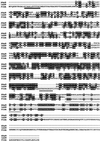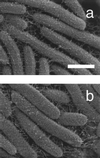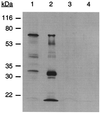An extracellular matrix-associated zinc metalloprotease is required for dilauroyl phosphatidylethanolamine chemotactic excitation in Myxococcus xanthus
- PMID: 11872719
- PMCID: PMC134888
- DOI: 10.1128/JB.184.6.1678-1684.2002
An extracellular matrix-associated zinc metalloprotease is required for dilauroyl phosphatidylethanolamine chemotactic excitation in Myxococcus xanthus
Abstract
An extracellular matrix connects bacteria that live in organized assemblages called biofilms. While the role of the matrix in the regulation of cell behavior has not been extensively examined in bacteria, we suggest that, like mammalian cells, the matrix facilitates cell-cell interactions involved with regulation of cohesion, motility, and sensory transduction. The extracellular matrix of the soil bacterium Myxococcus xanthus is essential for biofilm formation and fruiting body development. The matrix material is extruded as long, thin fibrils that mediate adhesion to surfaces, cohesion to other cells, and excitation by the chemoattractant dilauroyl phosphatidylethanolamine. We report the identification of a putative matrix-associated zinc metalloprotease called FibA (fibril protein A). Western blotting with FibA-specific monoclonal antibody 2105 suggests extensive proteolytic processing of FibA during assembly into fibrils, consistent with the autoprocessing observed with other members of the M4 metalloprotease family. Disruption of fibA had no obvious effect on the structure of the fibrils and did not inhibit cell cohesion, excitation by dioleoyl phosphatidylethanolamine, or activity of the A- or S-motility motors. However, the cells lost the ability to respond to dilauroyl phosphatidylethanolamine and to form well-spaced fruiting bodies, though substantial aggregation was observed. Chemotactic excitation of the fibA mutant was restored by incubation with purified wild-type fibrils. The results suggest that this metalloprotease is involved in sensory transduction.
Figures






Similar articles
-
FibA and PilA act cooperatively during fruiting body formation of Myxococcus xanthus.Mol Microbiol. 2006 Sep;61(5):1283-93. doi: 10.1111/j.1365-2958.2006.05298.x. Mol Microbiol. 2006. PMID: 16925559
-
Myxococcus xanthus fibril appendages are essential for excitation by a phospholipid attractant.Proc Natl Acad Sci U S A. 2000 Oct 10;97(21):11505-10. doi: 10.1073/pnas.210448597. Proc Natl Acad Sci U S A. 2000. PMID: 11016978 Free PMC article.
-
Lipid chemotaxis and signal transduction in Myxococcus xanthus.Trends Microbiol. 2001 Mar;9(3):126-9. doi: 10.1016/s0966-842x(01)01948-5. Trends Microbiol. 2001. PMID: 11239790 Review.
-
The Dif chemosensory pathway is directly involved in phosphatidylethanolamine sensory transduction in Myxococcus xanthus.Mol Microbiol. 2005 Sep;57(5):1499-508. doi: 10.1111/j.1365-2958.2005.04785.x. Mol Microbiol. 2005. PMID: 16102016
-
Gliding motility in bacteria: insights from studies of Myxococcus xanthus.Microbiol Mol Biol Rev. 1999 Sep;63(3):621-41. doi: 10.1128/MMBR.63.3.621-641.1999. Microbiol Mol Biol Rev. 1999. PMID: 10477310 Free PMC article. Review.
Cited by
-
Myxococcus xanthus chemotaxis homologs DifD and DifG negatively regulate fibril polysaccharide production.J Bacteriol. 2004 Feb;186(4):1001-8. doi: 10.1128/JB.186.4.1001-1008.2004. J Bacteriol. 2004. PMID: 14761994 Free PMC article.
-
Statistical image analysis reveals features affecting fates of Myxococcus xanthus developmental aggregates.Proc Natl Acad Sci U S A. 2011 Apr 5;108(14):5915-20. doi: 10.1073/pnas.1018383108. Epub 2011 Mar 21. Proc Natl Acad Sci U S A. 2011. PMID: 21436028 Free PMC article.
-
The Myxococcus xanthus spore cuticula protein C is a fragment of FibA, an extracellular metalloprotease produced exclusively in aggregated cells.PLoS One. 2011;6(12):e28968. doi: 10.1371/journal.pone.0028968. Epub 2011 Dec 12. PLoS One. 2011. PMID: 22174937 Free PMC article.
-
Myxobacteria: Moving, Killing, Feeding, and Surviving Together.Front Microbiol. 2016 May 26;7:781. doi: 10.3389/fmicb.2016.00781. eCollection 2016. Front Microbiol. 2016. PMID: 27303375 Free PMC article. Review.
-
Social conflict in centimeter-and global-scale populations of the bacterium Myxococcus xanthus.Curr Biol. 2009 Nov 3;19(20):1763-7. doi: 10.1016/j.cub.2009.08.061. Curr Biol. 2009. PMID: 19879146 Free PMC article.
References
Publication types
MeSH terms
Substances
Associated data
- Actions
LinkOut - more resources
Full Text Sources

